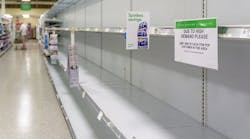It seems like every time there is an inventory problem, lean manufacturing or lean principles get the blame.
Store shelves were bereft of paper towels for weeks or months at a time during the early stages of the pandemic across the United States. Toilet paper couldn’t be found within hundreds of miles of your favorite drugstore. Even laptop computers were in short supply as swathes of employees suddenly had to transfer their work lives to home offices, and online learning became the go-to educational method for students.
The culprit behind these shortages, according to a recent Wall Street Journal article, is lean manufacturing, or just-in-time inventory, with its emphasis on keeping inventories zealously low.
That’s ridiculous.
It’s not the first time, and I’m sure it won’t be the last, that lean finds itself in the crosshairs of controversy. We at IndustryWeek wrote about the controversy in 2010, when lean manufacturing was being blamed for component shortages faced by Apple and Nissan, among others, as well as quality issues at Toyota. This despite the fact that, as one lean proponent pointed out back then, Apple was not considered a lean company, so how could adherence to lean principles have contributed to its inventory issues? (That said, one could fairly easily make the case that Apple does espouse certain lean principles.)
But back to my “that’s ridiculous” statement. First, all manufacturers must make decisions about how much inventory to carry, regardless of what manufacturing system they use—lean or not—and I defy anyone to point to a manufacturer that has deliberately built up sufficient inventory to address a once-in-a-lifetime (I hope) event like the pandemic.
More importantly, however, is the continued misconstruing of what lean is, from folks both within and outside of manufacturing. Lean is not one thing. Lean and just-in-time inventory are not synonymous. Minimal inventory does not mean that a company is lean.
I agree with a comment made by Theodore Duclos, CTO and COO for Freudenberg Sealing Technologies, with whom I spoke recently. He said that some people “have latched on to this one idea, or one dimension, of lean manufacturing being low inventory.”
But lean is not one dimensional. At its core, lean is about maximizing customer value while minimizing waste, to paraphrase wording from the Lean Enterprise Institute. Even more, the organization says, lean thinking “changes the focus of management from optimizing separate technologies, assets, and vertical departments to optimizing the flow of products and services through entire value streams.”
Duclos also made a good point about lean that frequently goes unaddressed when conversations edge toward the shortcomings of lean. Lean is also about being flexible, he said. Think about some of the tools and tactics of lean—quick changeover techniques, lot size reduction, level scheduling, even cross-training of employees. All of these practices, done well, help reduce lead times and enhance a manufacturing floor’s ability to more quickly address changes in demand or changes in product type.
You can extend that flexibility conversation to equipment as well, Duclos pointed out. Reports in the press indicated that some product shortages were exacerbated by manufacturing equipment designed to do one thing, and one thing only. When demand for that one thing dropped—but demand for another spiked—the lack of equipment flexibility was starkly illustrated. Where was the lean mindset here?
Lean has gotten a bad rap during this pandemic. If anything, crises like this one illuminate the continued lack of understanding of what lean is. That’s too bad.
Manufacturers that truly embrace lean will see the pandemic for what it is—a catalyst for change. COVID-19 has highlighted areas where manufacturing falls short; lean companies will attack those weaknesses and be better for it. That’s where lean shines.





